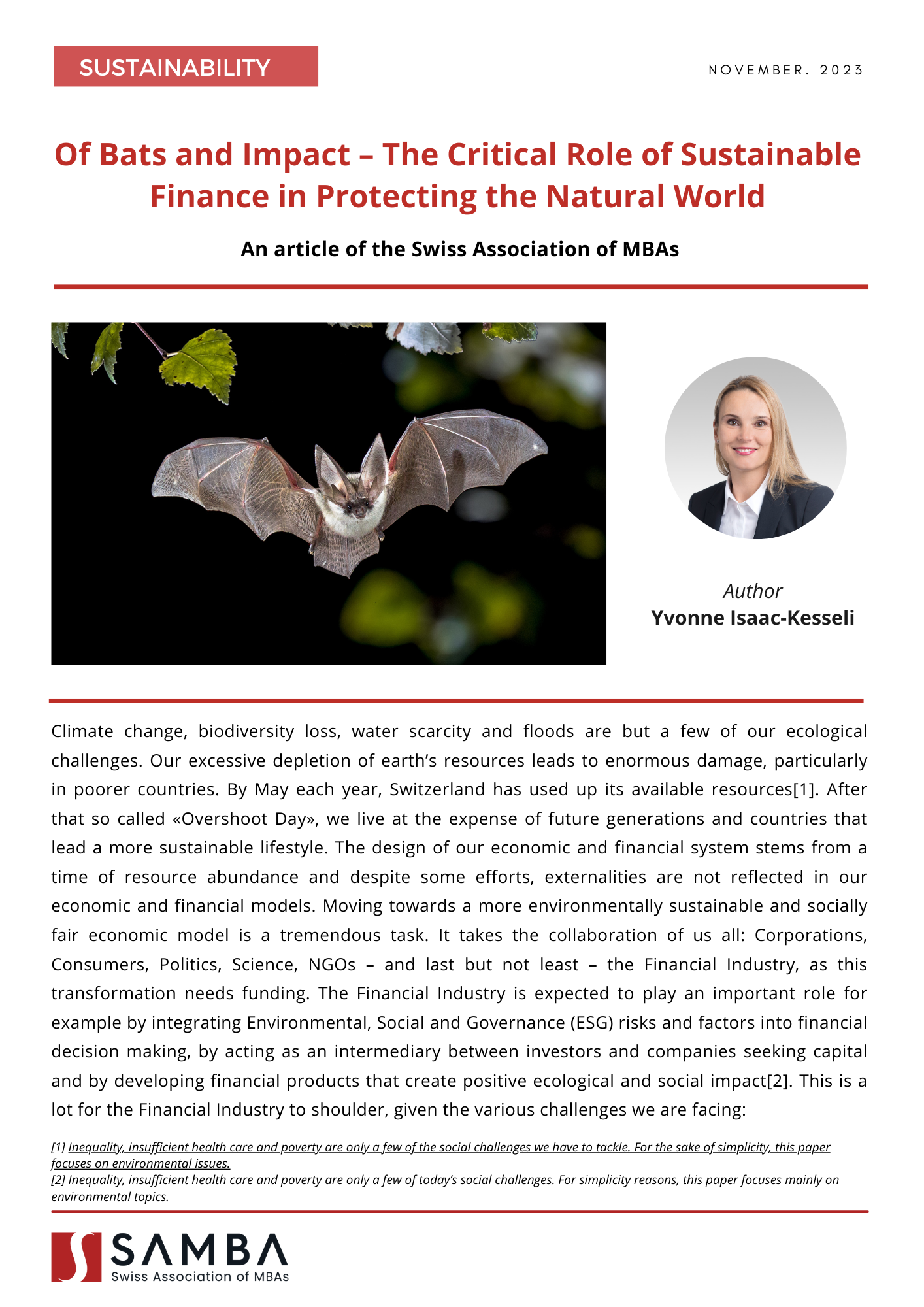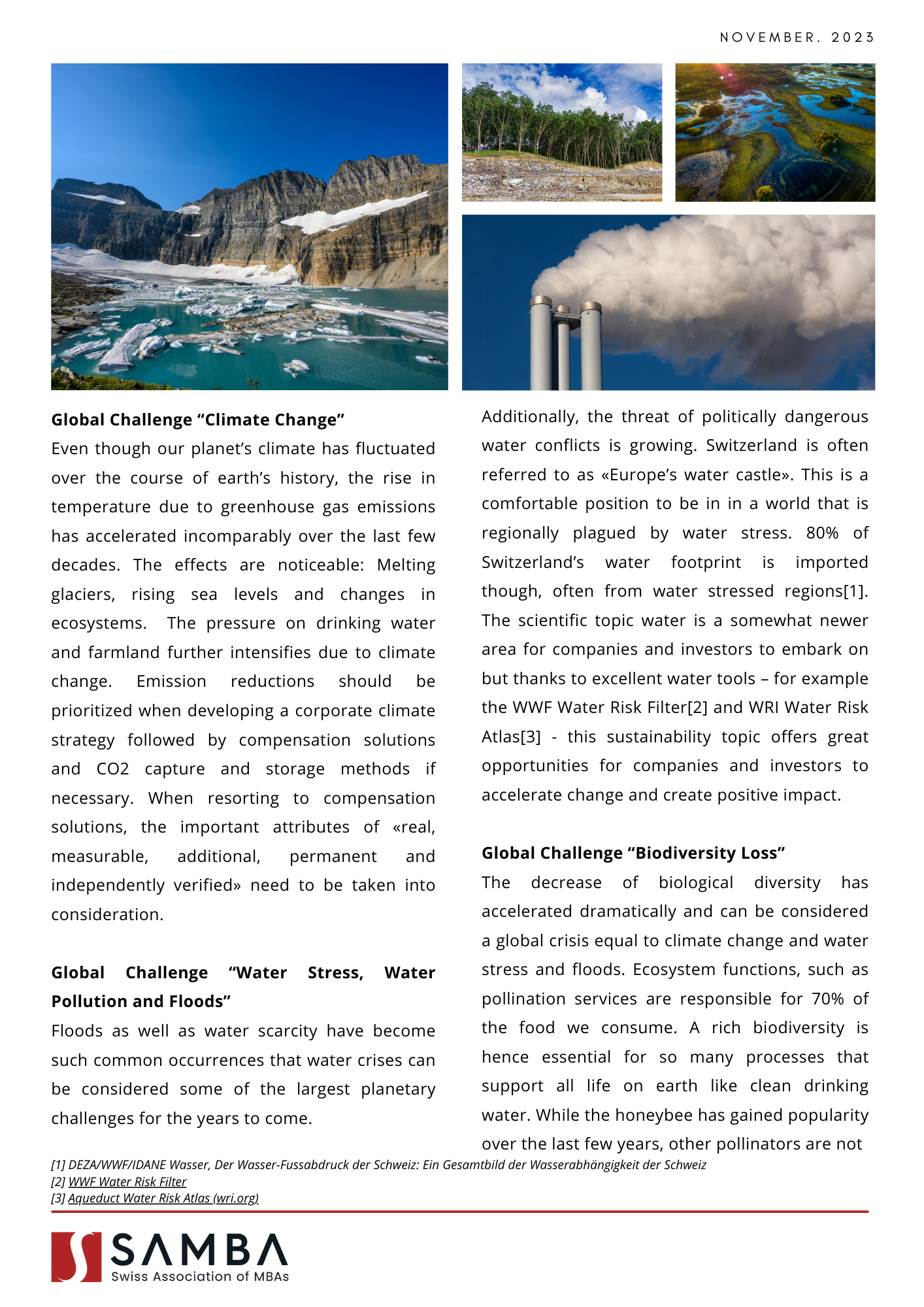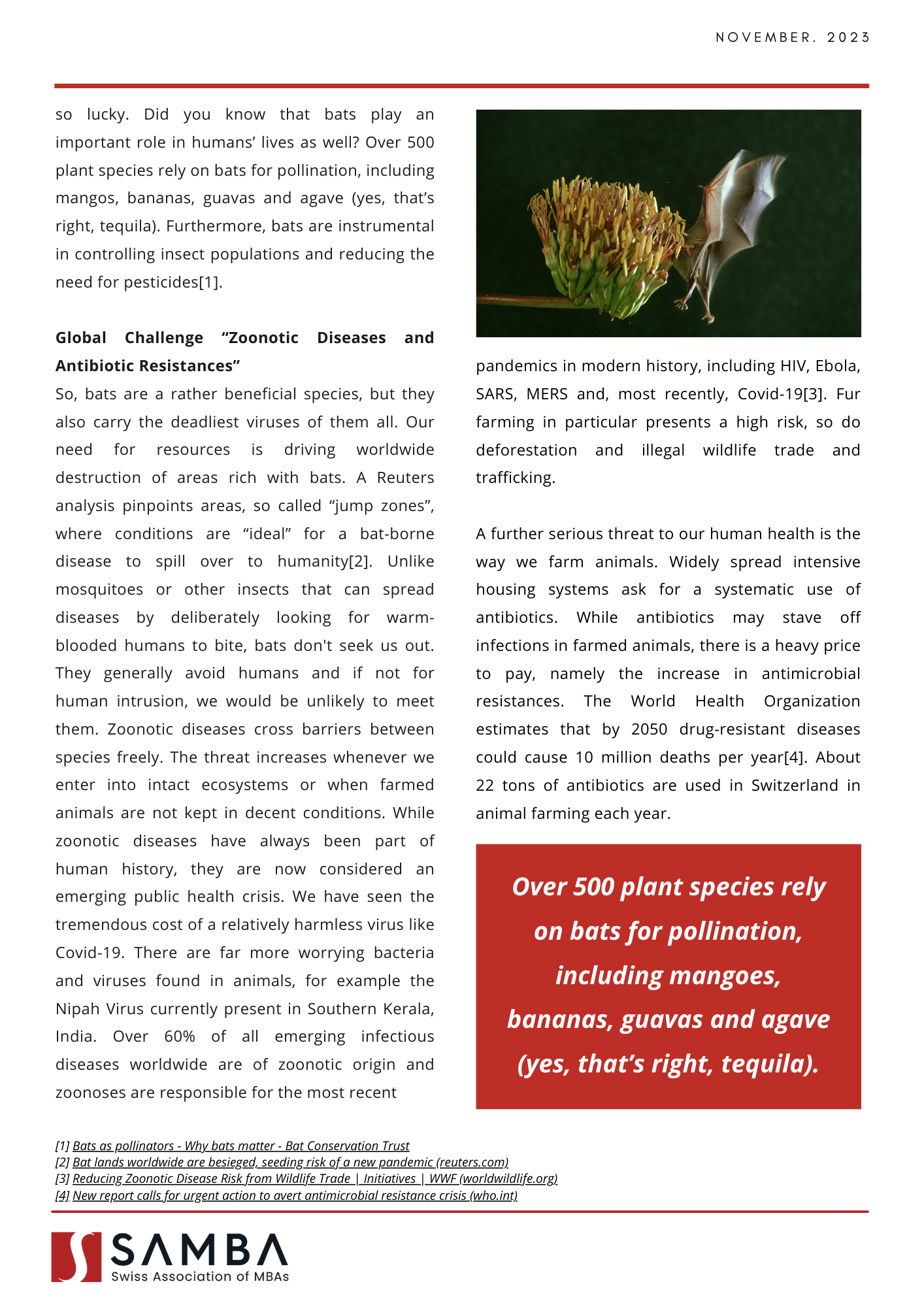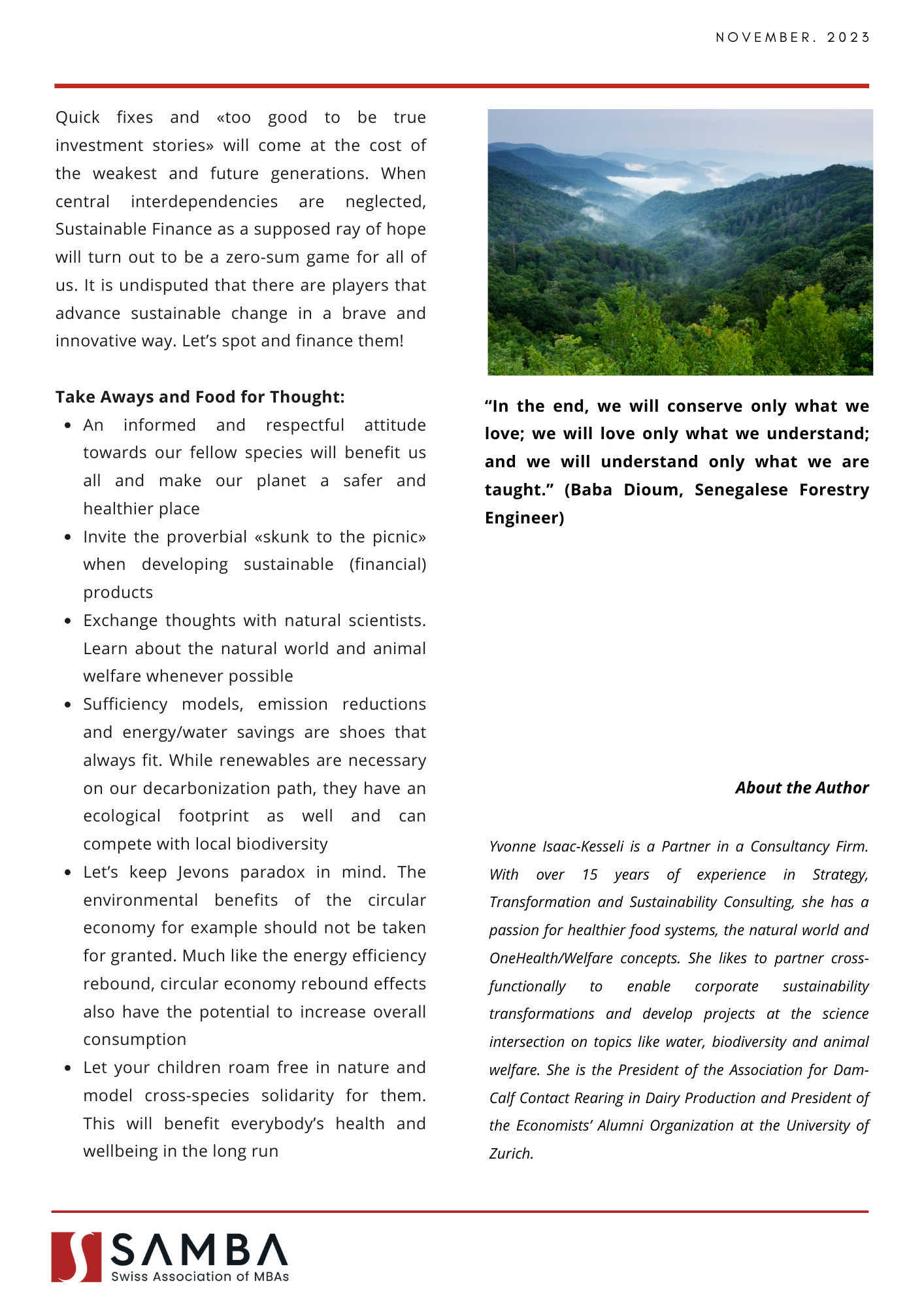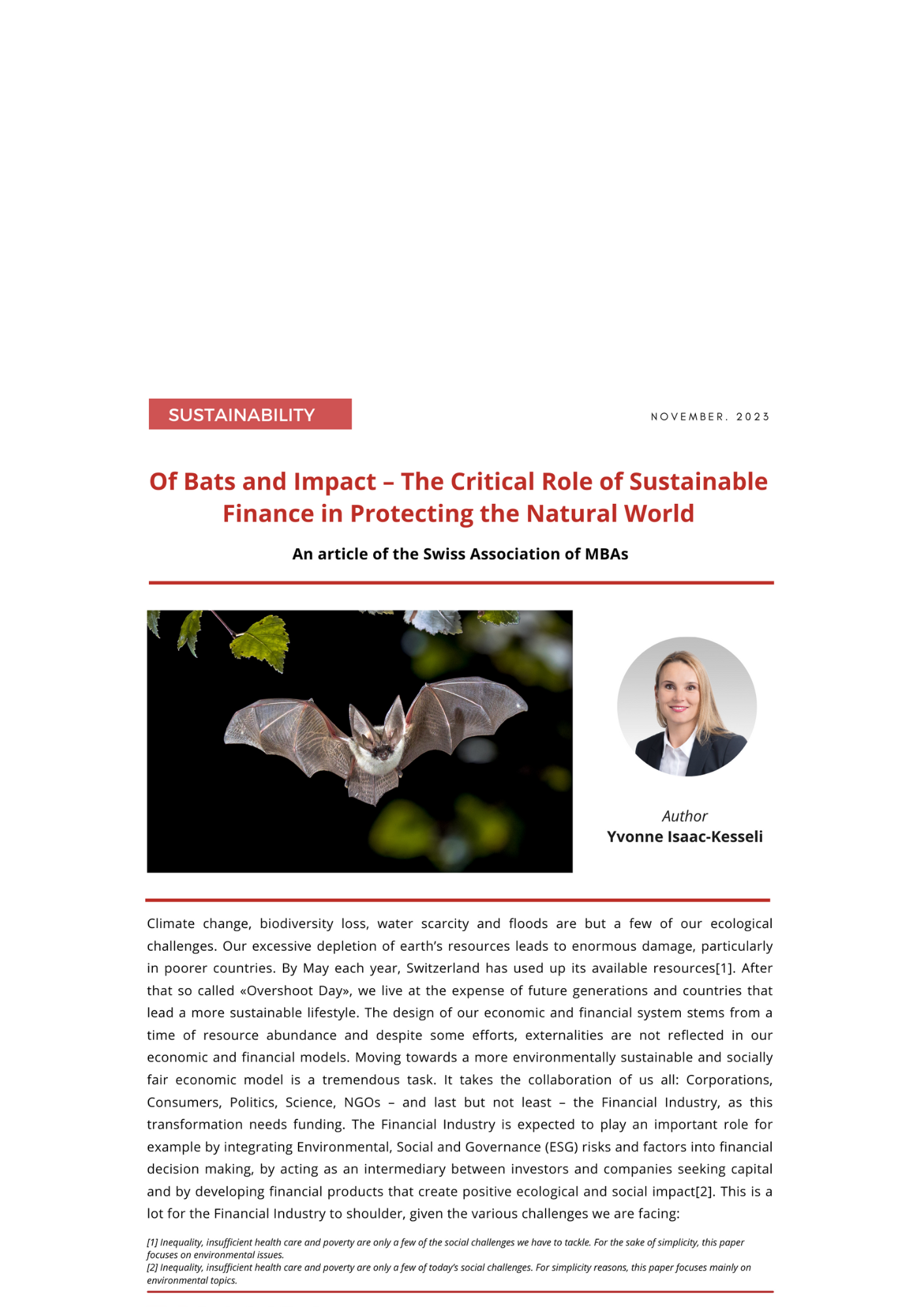
Climate change, biodiversity loss, water scarcity and floods are but a few of our ecological challenges. Our excessive depletion of earth’s resources leads to enormous damage, particularly in poorer countries. By May each year, Switzerland has used up its available resources . After that so called «Overshoot Day», we live at the expense of future generations and countries that lead a more sustainable lifestyle. The design of our economic and financial system stems from a time of resource abundance and despite some efforts, externalities are not reflected in our economic and financial models. Moving towards a more environmentally sustainable and socially fair economic model is a tremendous task. It takes the collaboration of us all: Corporations, Consumers, Politics, Science, NGOs – and last but not least – the Financial Industry, as this transformation needs funding. The Financial Industry is expected to play an important role for example by integrating Environmental, Social and Governance (ESG) risks and factors into financial decision making, by acting as an intermediary between investors and companies seeking capital and by developing financial products that create positive ecological and social impact . This is a lot for the Financial Industry to shoulder, given the various challenges we are facing:
Global Challenge “Climate Change”
Even though our planet’s climate has fluctuated
over the course of earth’s history, the rise in temperature due to greenhouse
gas emissions has accelerated incomparably over the last few decades. The
effects are noticeable: Melting glaciers, rising sea levels and changes in
ecosystems. The pressure on drinking
water and farmland further intensifies due to climate change. Emission
reductions should be prioritized when developing a corporate climate strategy
followed by compensation solutions and CO2 capture and storage methods if
necessary. When resorting to compensation solutions, the important attributes
of «real, measurable, additional, permanent and independently verified» need
to be taken into consideration.
Global Challenge “Water Stress, Water Pollution and Floods”
Floods as well as water scarcity have become such common occurrences that
water crises can be considered some of the largest planetary challenges for the
years to come. Additionally, the threat of politically dangerous water conflicts
is growing. Switzerland is often referred to as «Europe’s water castle».
This is a comfortable position to be in in a world that is regionally plagued
by water stress. 80% of Switzerland’s water footprint is imported though, often
from water stressed regions[1].
The scientific topic water is a somewhat newer area for companies and investors
to embark on but thanks to excellent water tools – for example the WWF Water
Risk Filter[2]
and WRI Water Risk Atlas[3]
- this sustainability topic offers great opportunities for companies and
investors to accelerate change and create positive impact.
Global Challenge “Biodiversity Loss”
The decrease of biological diversity has accelerated dramatically and can
be considered a global crisis equal to climate change and water stress and
floods. Ecosystem functions, such as pollination services are responsible for
70% of the food we consume. A rich biodiversity is hence essential for so many
processes that support all life on earth like clean drinking water. While the
honeybee has gained popularity over the last few years, other pollinators are
not so lucky. Did you know that bats play an important role in humans’ lives as
well? Over 500 plant species rely on bats for pollination, including mangos,
bananas, guavas and agave (yes, that’s right, tequila). Furthermore, bats are
instrumental in controlling insect populations and reducing the need for
pesticides[4].
Global Challenge “Zoonotic Diseases and Antibiotic Resistances”
So, bats are a rather beneficial species, but they also carry the deadliest
viruses of them all. Our need for resources is driving worldwide destruction of
areas rich with bats. A Reuters analysis pinpoints areas, so called “jump
zones”, where conditions are “ideal” for a bat-borne disease to
spill over to humanity[5]. Unlike
mosquitoes or other insects that can spread diseases by deliberately looking
for warm-blooded humans to bite, bats don't seek us out. They generally avoid
humans and if not for human intrusion, we would be unlikely to meet them. Zoonotic
diseases cross barriers between species freely. The threat increases whenever
we enter into intact ecosystems or when farmed animals are not kept in decent
conditions. While zoonotic diseases have always been part of human history,
they are now considered an emerging public health crisis. We have seen the tremendous
cost of a relatively harmless virus like Covid-19. There are far more worrying
bacteria and viruses found in animals, for example the Nipah Virus currently present
in Southern Kerala, India. Over 60% of all emerging infectious diseases
worldwide are of zoonotic origin and zoonoses are responsible for the most
recent pandemics in modern history, including HIV, Ebola, SARS, MERS and, most
recently, Covid-19[6].
Fur farming in particular presents a high risk, so do deforestation and illegal
wildlife trade and trafficking.
A further serious threat to our human health is the way we farm animals.
Widely spread intensive housing systems ask for a systematic use of
antibiotics. While antibiotics may stave off infections in farmed animals,
there is a heavy price to pay, namely the increase in antimicrobial
resistances. The World Health Organization estimates that by 2050 drug-resistant
diseases could cause 10 million deaths per year[7]. About 22
tons of antibiotics are used in Switzerland in animal farming each year. The federal
“Strategy on Antibiotic Resistance Switzerland (StAR)”[8] aims to
look into these topics focusing on collaboration between human and veterinary
medicine, agriculture and natural sciences to find solutions. This is a central
topic in Academia as well. The University of Zurich has just jointly founded a
OneHealth Institute by the Vetsuisse Faculty and the Faculties of Medicine and
Science[9]. Clearly, the health of humans, animals and
our environment are tightly interrelated. If we wish to create positive environmental
impact, we need to become more familiar with the various species we
are sharing this beautiful planet with. Assessing and avoiding the risks the
natural world and our farming methods pose and at the same time investing in accelerating
positive change improves the health and welfare of all of us. OneHealth[10] and
OneWelfare[11]concepts
are interesting Impact Investing candidates. Let’s be creative!
Environmental Challenges are Interrelated
Despite scientific proof of interdependencies between climate,
biodiversity and water, these systems are often still perceived and treated as
independent phenomena and environmental efforts reduced to a focus on CO2
emissions. They can only be solved together and should not be played off
against each other. The need for collaboration between the disciplines is also
repeatedly stressed by the IPCC (Intergovernmental Panel on Climate Change) and
the IPBES (Intergovernmental Science-Policy Platform on Biodiversity and
Ecosystem Services)[12].
Let’s apply a more holistic and interdisciplinary approach when developing
sustainable solutions.
Global Challenges and the Financial Industry
A rapid increase in sustainable consumer and financial
products is noticeable. But how can these products indeed help in reducing greenhouse
gas emissions, revert biodiversity loss and ease water stress? How can the Financial Industry spot and support
sustainable players that are pushing for real and measurable change? For
financial products to create positive change, we need clear criteria and market
signals, interdisciplinary collaboration und serious efforts to disclose
greenwashing whenever possible[13],
for example by avoiding vague claims such as «environmentally friendly» and
«net zero» without providing further details. Sustainable investors and (venture)
philanthropists have a myriad of possibilities to choose from. But only with
open eyes, solid data, a focus on systemic interdependencies and common sense
can the challenges of our times be tackled. Quick fixes and «too good to be
true investment stories» will come at the cost of the weakest and future
generations. When central interdependencies are neglected, Sustainable Finance as
a supposed ray of hope will turn out to be a zero-sum game for all of us. It is
undisputed that there are players that advance sustainable change in a brave
and innovative way. Let’s spot and finance them!
Take Aways and Food for Thought:
- - An informed and respectful attitude towards our fellow species will benefit us all and make our planet a safer and healthier place
- - Invite the proverbial «skunk to the picnic» when developing sustainable (financial) products
- - Exchange thoughts with natural scientists. Learn about the natural world and animal welfare whenever possible
- - Sufficiency models, emission reductions and energy/water savings are shoes that always fit. While renewables are necessary on our decarbonization path, they have an ecological footprint as well and can compete with local biodiversity
- - Let's keep Jevons paradox in mind. The environmental benefits of the circular economy for example should not be taken for granted. Much like the energy efficiency rebound, circular economy rebound effects also have the potential to increase overall consumption
- - Let your children roam free in nature and model cross-species solidarity for them. This will benefit everybody’s health and wellbeing in the long run
«In the end, we
will conserve only what we love; we will love only what we understand; and we
will understand only what we are taught.” (Baba Dioum,
Senegalese Forestry Engineer)
[1] DEZA/WWF/IDANE Wasser, Der Wasser-Fussabdruck der Schweiz: Ein Gesamtbild der Wasserabhängigkeit der Schweiz
[10] One Health' is an
integrated, unifying approach to balance and optimize the health of people,
animals and the environment
[11] One Welfare extends
the approach of (and partially overlaps) the One Health theme used for human
and animal health. A One Welfare approach promotes the direct and indirect
links of animal welfare to human welfare and environmentally friendly
animal-keeping systems
[13] i.A. Thomas
Vellacott (2021). Standpunkt: Glaubwürdige Impact-Messung. Die
Volkswirtschaft, 30. April.

